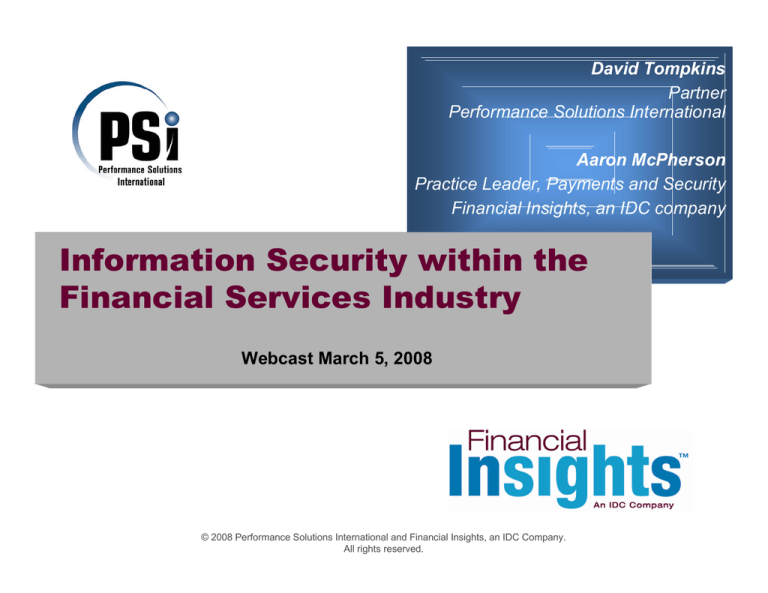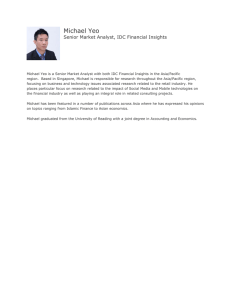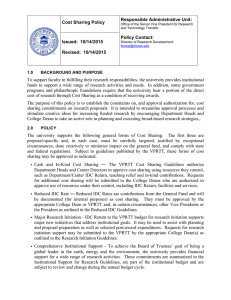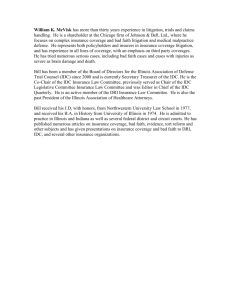
David Tompkins
Partner
Performance Solutions International
Aaron McPherson
Practice Leader, Payments and Security
Financial Insights, an IDC company
Information Security within the
Financial Services Industry
Webcast March 5, 2008
© 2008 Performance Solutions International and Financial Insights, an IDC Company.
All rights reserved.
Webcast Logistics
Audio lines are muted until Q&A session
Submit your questions via the Live Meeting Chat window at
any time (or audio at end)
Slides available within 24 hours for all attendees
Technical Problems
– Email dstark@idc.com
All other requests:
– Email sales@financial-insights.com
– Email info@goto-psi.com
© 2008 Performance Solutions International and Financial Insights, an IDC Company.
All rights reserved.
2
Our Partnership Provides You With…
Blended solution that leverages data driven research and training
with years of experience in the financial services industry
–
–
–
–
–
A logical and proven method for learning the industry fundamentals
Business drivers and challenges at the CXO and LOB levels
Highly customizable training
Continuous knowledge transfer with ongoing subscription
An ongoing dialogue with:
• Financial Insights' expert analysts to support key investment decisions and
go-to-market strategies
• PSI Instructors to discuss the application of the training
© 2008 Performance Solutions International and Financial Insights, an IDC Company.
All rights reserved.
3
Agenda for Today’s Session
Business and regulatory drivers
Information security threats
Tools and strategies used by
financial institutions
Information security IT ecosystem
Top 10 security concerns
Essential guidance and summary
Questions and answers
– Live meeting chat or audio
© 2008 Performance Solutions International and Financial Insights, an IDC Company.
All rights reserved.
4
Introducing Our Speakers
Aaron McPherson, Research Director, Payments and Security
– Specializes in the strategic implications of new
technology for the payments industry
– Provides analysis on the strengths and weaknesses
of payment industry competitors
– Previously with IDC American Management Systems
(AMS), and as a financial analyst in the Executive
Office of the Commonwealth of Massachusetts
David Tompkins, Partner, Performance Solutions International
– Co-founding Partner of PSI
– 20 years of experience in financial services industry, working with
financial institutions, regulators, consulting firms and solution providers
– Currently responsible for PSI's financial services industry training
curriculum, including client deliveries and new course development
© 2008 Performance Solutions International and Financial Insights, an IDC Company.
All rights reserved.
5
And now David Tompkins..
© 2008 Performance Solutions International and Financial Insights, an IDC Company.
All rights reserved.
PSI’s Financial Services Industry Curriculum
Source: Information Security in Financial Services training program, PSI
© 2008 Performance Solutions International. All rights reserved.
7
Business and Regulatory Drivers
Today’s Threat to Information Security
Greater reliance on IT to store
and process information
Attacks are becoming
more sophisticated
– Organized crime, terrorists
– Increasing value of stolen information
Increasing costs of data breaches
– Investigation and auditing
– Customer communication
– Litigation (increasing public awareness)
Source: Information Security in Financial Services training program, PSI
© 2008 Performance Solutions International. All rights reserved.
8
Business and Regulatory Drivers
Do Financial Institutions Care?
Financial services is the most targeted industry
Reputational risk is high
“The
Regulatory burden
“Thebiggest
biggestrisk
riskisn't
isn'tthe
the
is increasing
– Consumer privacy
and protection
– Exposure to third parties
– Conflicting regulations
Internet is critical to
loss
lossitself
itselfbut
butthe
thebank's
bank's
reputation.”
reputation.”
Karl
KarlLandert,
Landert,
CIO
Private
CIO PrivateBanking
Bankingand
and
EMEA,
EMEA,Credit
CreditSuisse
Suisse
Bank
BankSystems
Systems&&Technology,
Technology,
May
24,
2007
May 24, 2007
long-term strategic plans
Third-party breaches impact financial institutions
Direct financial losses can be significant
Source: Information Security in Financial Services training program, PSI
© 2008 Performance Solutions International. All rights reserved.
9
Information Security Threats in Financial Services
Protecting Physical Assets
High profile incidences of stolen/lost laptops
and data tapes
How are financial institutions
responding?
–
–
–
–
Staff education
Data encryption
Hard-disk-lock passwords
Extending to other portable devices
(mobile devices, USB drives)
– “Remote kill”
Source: Information Security in Financial Services training program, PSI
© 2008 Performance Solutions International. All rights reserved.
10
Information Security Threats in Financial Services
Internal Threats
75% of measured security
losses are internal
Internal threats include
– Staff carelessness
– Internal fraud and theft
How are financial
institutions responding?
“The
“Thethings
thingsthat
thatkeep
keepme
me
awake
awakeat
atnight
nightare
areall
all
around
aroundstaff
stafffraud.
fraud. ItItisisaa
massive
massiveproblem.
problem.We’re
We’renot
not
good
goodat
atspotting
spottingand
and
stopping
stoppingit.”
it.”
Derek
DerekWylde,
Wylde,
Group
Head
Group Headof
ofFraud,
Fraud,HSBC
HSBC
The
TheBanker,
Banker,November
November6,
6,2006
2006
– Internal policies
and processes
– Staff education and
background checks
– Physical security measures in data centers
– User authentication and authorization
Source: Information Security in Financial Services training program, PSI
© 2008 Performance Solutions International. All rights reserved.
11
Information Security Threats in Financial Services
External Threats
External threats include
– Hacking
– Attacks on customers
– Emerging threats
How are financial institutions
responding?
–
–
–
–
–
–
Perimeter security
User authentication and authorization
Patch management
Customer education
New customer services
Working with third parties
to improve controls
– Multifactor authentication
Source: Information Security in Financial Services training program, PSI
© 2008 Performance Solutions International. All rights reserved.
12
Information Security
IT Ecosystem
Internal Employees
Partners (e.g., outsourcing providers)
Corporate Clients
Internet
Internet
DMZ
Data Center
VPN
VPN
LAN
LAN
Card
Manager
WAN
WAN
Web
Server
DNS
Server
Mail
Server
• ACL
Security
Server
Access
Control
Server
Intrusion
Detection
System
Application Server
Intrusion
Prevention
System
Application Server
Internet
Banking
Application
Server
Internal
Mail
Server
Application Server
Source: Information Security in Financial Services training program, PSI
© 2008 Performance Solutions International. All rights reserved.
13
Information Security Management
Security is becoming a “C-level” issue
Great focus IS governance
– Management structures
– Strategies, policies, procedures
and standards
– Reporting (internal, regulatory)
– Controls assessments, testing and audit
Adhering to industry standards
(ISO/IEC 27002: 2005)
Centralizing IS management
Source: Information Security in Financial Services training program, PSI
© 2008 Performance Solutions International. All rights reserved.
14
Why Aren’t Financial Institutions Doing More?
Information security is less than 3% of IT budgets
– Considered a cost, not an investment
View of information security
applications as
– Complex and burdensome
– A strain on network and
system resources
– Difficult to deploy and maintain
Need to balance cost of
information security with
– Actual losses
– Reputational and regulatory risks
Source: Information Security in Financial Services training program, PSI
© 2008 Performance Solutions International. All rights reserved.
15
And now Aaron McPherson..
© 2008 Performance Solutions International and Financial Insights, an IDC Company.
All rights reserved.
Top 10 Security Concerns of Financial
Institution CIOs and CTOs
Protecting the Customer Connection
1. Securing Consumer PCs
2. Improving Account Opening
3. Credentialing – Verifying Identity of Both Customer and Institution Online
Compliance Issues
4. Inconsistent State-Level Data Breach Laws
5. Inconsistencies Between Security Standards, Risk Models, and Maturity
6.
Models
PCI Compliance
Managing and Understanding the Problem
7. Creation of a Fraud Taxonomy to Facilitate Comparisons of Technology and
8.
9.
10.
Exchange of Data
Quantifying the Effectiveness of Security Measures and Processes
Resiliency and Disaster Recovery
Records Management
17
© 2008 Financial Insights, an IDC Company. All rights reserved.
Protecting the Customer Connection
Phishing continues to be an issue
– One bank found itself shutting down over 1,000 fake sites
– Customers were being tricked into giving over challenge questions as
well as answers
– Use of challenge questions may actually make consumers less secure
by encouraging them to reveal more personal information
As consumers become more aware of phishing, fraudsters are
switching tactics
– “Vishing,” or spoofed interactive voice response (IVR) lines, are
beginning to appear
Most CIOs and CTOs we spoke with expressed uncertainty
about what the proper solution would be
– Sending a password via mobile phone text message?
– Password generation via hardware token?
– Biometric scan on the keyboard or attached device?
18
© 2008 Financial Insights, an IDC Company. All rights reserved.
Compliance Issues: Inconsistent State-Level
Data Breach Laws
In response to widely publicized data breaches like the TJX incident
(more than 40 million cards compromised), dozens of states have
enacted separate data breach laws
– Consumer activism is strongest at the state level
Many laws do not distinguish clearly between theft of a card number
(transactional fraud) and identity theft, criminalizing both
– This creates legal risks for banks, particularly those that service
merchants who accept cards
Inconsistent laws require additional resources at the bank level to
ensure compliance for those institutions that operate nationally
Obvious solution is a pre-emptive federal law… but what form
should it take?
– General nervousness about pushing for additional regulation.
– Upcoming elections make it difficult to get action through Congress
19
© 2008 Financial Insights, an IDC Company. All rights reserved.
Inconsistencies Between Security Standards,
Risk Models, and Maturity Models
Between August and December 2007, a group of financial industry,
insurance, consulting and vendor executives met under the
sponsorship of the International Committee for Information
Technology Standards (INCITS), the main US organization for IT
standards.
The group delivered a report, available at
http://www.incits.org/tc_home/sbp/sbp070049.pdf, which found
that:
– There are three distinct types of standards that financial institutions
employ in the information security space:
• compliance frameworks,
• risk management models, and
• maturity models.
– The users must devote resources to integrate these standards, since
the reference documents themselves are developed independently.
– Users are usually not involved in the development of the standards,
seeing it as a non-revenue generating activity.
20
© 2008 Financial Insights, an IDC Company. All rights reserved.
Inconsistencies Between Security Standards,
Risk Models, and Maturity Models
The study group recommended that a taxonomy be developed to
establish a common frame of reference for all standards to follow,
making it easier to map them onto each other
– The Financial Services Technology Consortium is currently working on a
similar taxonomy, although for fraud rather than information security in
general
In addition, the study group urged an awareness campaign be
mounted to ensure that financial institutions were aware of the
standards that existed to guide them in securing their systems.
Risk models should be modified to handle low likelihood, high impact
events with greater sensitivity, assigning different levels of control to
different levels of risk.
Finally, the study group urged standards bodies, regulators, and
financial institutions to find ways to work together more effectively with
each other as well as with other stakeholders such as third-party
processors and customers.
21
© 2008 Financial Insights, an IDC Company. All rights reserved.
Payment Card Industry (PCI)
Security Standard Overview
Establishes a minimum benchmark for secure processing of
card payments
Focuses on six main areas:
–
–
–
–
–
–
Build and Maintain a Secure Network
Protect Cardholder Data
Maintain a Vulnerability Management Program
Implement Strong Access Control Measures
Regularly Monitor and Test Networks
Maintain an Information Security Policy
22
© 2008 Financial Insights, an IDC Company. All rights reserved.
PCI Compliance Efforts
Current enforcement efforts are focused on “Level 1 and 2”
merchants
–
–
–
–
–
Level 1: more than 6 million transactions/year
Level 2: 1-6 million transactions/year
Annual on-site audits and quarterly reviews
Main issue is storage of “full track” magnetic stripe data and PINs
Acquirers (merchant banks) face escalating monthly fines of $5,000$25,000/merchant for non-compliance
Deadlines:
– September 30, 2006: All acquirers had to submit a PCI compliance
plan for their Level 1 merchants
– September 30, 2007: All Level 1 merchants must have validated
compliance
– December 31, 2007: All Level 2 merchants must have validated
compliance
Source: RSA Security Survey, March 2007
23
© 2008 Financial Insights, an IDC Company. All rights reserved.
PCI Compliance – a Mixed Bag
Visa announced incentive payments in December for compliance by
March 31, 2007
Lower interchange rates will be offered
As of January 22, 2008, according to Visa:
– More than 75% of Level 1 merchants were compliant;
– Nearly 66% of Level 2 merchants were compliant.
This still leaves a lot of merchants out of compliance!
– Most of the level 3’s and 4’s
– Merchant processing banks increasingly worried they may be held
liable because they have the “deep pockets.”
– Congress considering legislation to hold merchants liable for the costs
of security breaches.
– Courts have so far upheld the right of issuers to hold merchants liable.
– Even without liability, fines can be expensive – Fifth Third has already
paid Visa over $0.8 million in fines over the TJX breach
24
© 2008 Financial Insights, an IDC Company. All rights reserved.
Managing and Understanding the Problem
No consistent, universally accepted measure of fraud:
– 2007 AFP Payments Fraud Survey:
•
•
•
•
Only surveyed corporates
Limited to check and ACH fraud
42% of those reporting fraud suffered no actual losses
No attempt to estimate total losses to the US economy
– CyberSource 8th Annual Online Fraud Report
• Only surveyed online merchants (n=351)
• Limited to cards and ACH
– FTC Internet-Related Fraud Complaints
• Consumers, self reported (n=204,881)
• Limited to wire, credit card and check
25
© 2008 Financial Insights, an IDC Company. All rights reserved.
How Well is Bank of America Doing on
Security?
Bank of America received
many press mentions in 2006
for its SiteKey security
system, which used a
customer-selected picture and
challenge questions to
prevent phishing and increase
security. This system was
adopted by many US banks.
However, according to recent
report based on FTC
complaints gained through
Freedom of Information Act
requests, BofA was 2nd worst
in the US 2006 with 17.6
incidents of ID theft per $1B in
deposits.
Bottom line: we need a
consistent way to compare
performance and measure
progress
Source: “Measuring Identity Theft at Top Banks,” Hoofnagle, Chris, 2008. Available at
http://www.finextra.com/finextra-downloads/newsdocs/hoofnagle.pdf
26
© 2008 Financial Insights, an IDC Company. All rights reserved.
Efforts to Manage and Understand the Problem
Financial Services Technology Consortium:
– “Better Collaboration Tools for Fighting Fraud - Real-time Sharing of
information for Fighting Fraud” Project
• Goal is to determine what sorts of information can be shared, and through
what means
• Fraud taxonomy has been developed to guide discussion
– “Resiliency Model Initiative: Phase 3”
• FSTC has been working with Carnegie Mellon’s Software Engineering
Institute to develop a resiliency model.
• Resiliency has come to encompass not only natural disasters, but also
physical and cyber attacks.
• Phase 3 is aimed at piloting the model that has been worked out to field
test it
• Ultimate goal is a model that can be used for benchmarking as well as
establishing an initial plan.
Records Management
– Many CIOs interested in the issue of e-mail retention
27
© 2008 Financial Insights, an IDC Company. All rights reserved.
Essential Guidance and Summary
Regulations, sophisticated criminals and high levels of reputational
risk continue to make information security a top IT strategic initiative
for financial institutions
Successful information security management requires a coordinated
strategy involving security governance, applications, systems and
services
Financial institutions need to find a way to make the benefits of
information security investments show up in business cases
– Too often, they lose out to “revenue producing” initiatives, even though
they prevent revenue losing events
– See “Innovation Killers”, Harvard Business Review, January 2008
There is an urgent need for greater collaboration:
– Between financial institutions and government
– Between financial institutions and their customers
– Between the financial institutions themselves
Technology is only part of the solution: social and organizational
factors are at least as important
© 2008 Performance Solutions International and Financial Insights, an IDC Company.
All rights reserved.
28
Questions? Live Meeting Chat or Audio
David Tompkins, Partner
Performance Solutions International
dtompkins@goto-psi.com
Aaron McPherson, Practice Director
Payments and Security
Financial Insights, an IDC company
amcpherson@financial-insights.com
Slides will be posted and an email will be sent.
© 2008 Performance Solutions International and Financial Insights, an IDC Company.
All rights reserved.
29
Thank you
for attending!
Information Security within the
Financial Services Industry
Webcast March 5, 2008
© 2008 Performance Solutions International and Financial Insights, an IDC Company.
All rights reserved.




